

Global high-mix volume high-speed PCBA manufacturer
9:00 -18:00, Mon. - Fri. (GMT+8)
9:00 -12:00, Sat. (GMT+8)
(Except Chinese public holidays)


Global high-mix volume high-speed PCBA manufacturer
9:00 -18:00, Mon. - Fri. (GMT+8)
9:00 -12:00, Sat. (GMT+8)
(Except Chinese public holidays)
HomePage > Blog > Knowledge Base > About Keyboard PCB | All You Want to Know
Custom mechanical keyboards have gained widespread popularity due to their versatility, functionality, and appeal to both gamers and tech enthusiasts. It is their favorite for gaming, typing, and everything for tech geeks. Underneath the heart of every custom mechanical keyboard is a very fundamental component: the keyboard PCB. It is what provides a backbone by bringing together the switches, stabilizers, and other electronic components into one piece of engineering. This guide provides the key to understanding how keyboard PCBs work, choosing the right one, and finally, customizing your very own.

It is designed for electrical engineers who would love to increase their knowledge, as well as hobbyists wanting to try their hand at a custom build. We will cover types of keyboard PCBs, essential components, and design processes, providing much insight into how to choose or design the ideal keyboard PCBs to suit one's needs.
Actually, the keyboard PCB is the central nervous system of the mechanical keyboard. In effect, it's an electrical circuit board embedded inside, more or less thin. They basically decide how your switches work and communicate. The principal role of a PCB keyboard is the logging of keystrokes and sending them into a form readable by your computer so that each keystroke will be reflected on the screen correctly.
While membrane keyboards rely considerably on PCBs, mainly because of the stronger and much more customizable designed build, most mechanical keyboard PCBs are of the matrix variety, grid-like in design, which correlates rows and columns of switches in order to determine which key is pressed. The type of PCB used should bear a bearing on the typing experience, beginning with the ease of customizing this keyboard.
Knowing what a PCB keyboard is, besides what kind is best, will lead readers to a grasp of the wide use and adjustment spaces in mechanical keyboards.
Hot-swappable keyboard PCB is literally a game-changer for those customization enthusiasts. This kind of PCB allows a user to replace switches without bothering to disassemble the keyboard or soldering. Whether the types are experimentally tried for tactile feedback or different mechanical switches based on mood, the PCB really makes the switch very convenient and stress-free.
These are different from other PCBs in design. They are flexible and can bend or fold to fit inside very compact or non-traditional keyboard designs. They are extremely resilient and resistant to vibrations, making them the ideal solution for portable or nonstandard keyboard PCB layouts. They are thus being widely used in industrial and commercial applications where durability is paramount.
No-brainers for bright graphics, RGB-enabled gaming keyboard PCBs usually are LED-infused boards. They generate millions of colors and can be breathtakingly gorgeous in lighting effects, looking to amplify the feel of your game night. Most RGB keyboard PCB boards come along with software suites so that users can actually alter lighting patterns synchronized by the key strips and beats.
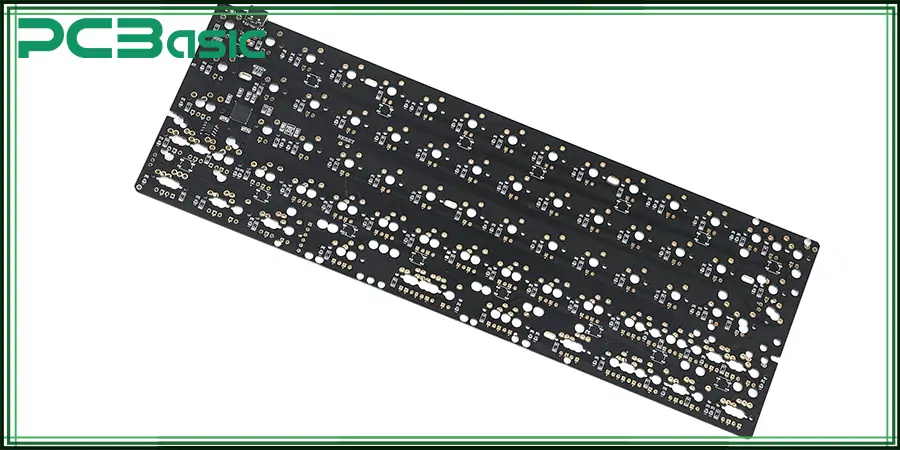
Laptop keyboard PCBs tend to be designed as flat, single-piece layouts and PCBs for such keyboard designs are usually fitted to hold membranes or butterfly mechanisms that lend further support to the space efficiency and ultra responsiveness that serve to make the laptop thinner but on an even keel for smooth typing.
Wired and Wireless keyboard PCBs are today available in both wire-bound and wireless forms. The former are reliable, fast, and less latency; it provides mobility without any cluttering of configuration. It uses the technology of Bluetooth/RF for communication.
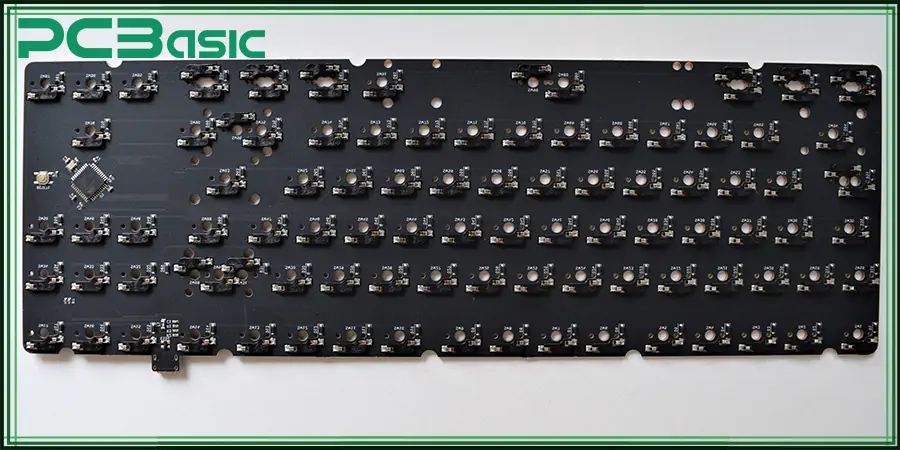
The processor microcontroller sorts the brain of the keyboard. It takes your keyboard signal and converts it into action on your device. A more powerful processor allows faster and more stable processing of multiple keystrokes, making for a really seamless experience during rapid typing or gaming sessions.
The matrix is a grid structure interconnecting the keys and the processor. This makes it easier to process the signal as all the connections are systematized with no chance of signal conflict, thus improving overall speed and accuracy in registering keystrokes.
Along with the basic components, this keyboard PCB has a great set of other parts, which allow it to act and behave as well as possible. Diodes are part of the design that ensures proper direction toward current flow across the board. This smart design prevents errors in circuits from circulating at the return current to the board; this also has a resource to protect great registration. Connectors connect the PCB to a computer and other peripherals, which establish important pathways for data transmission.
Electric circuits were indicated by tiny silver lines on the PCB, which outlined where signal lines interconnect elements. The microcontroller was in charge of everything that happened on board. The capacitors and resistors managed the overall power flow to keep signals accurate and reliable. With all that, the keyboard turned strong, performed well, and responded fast even after ages.
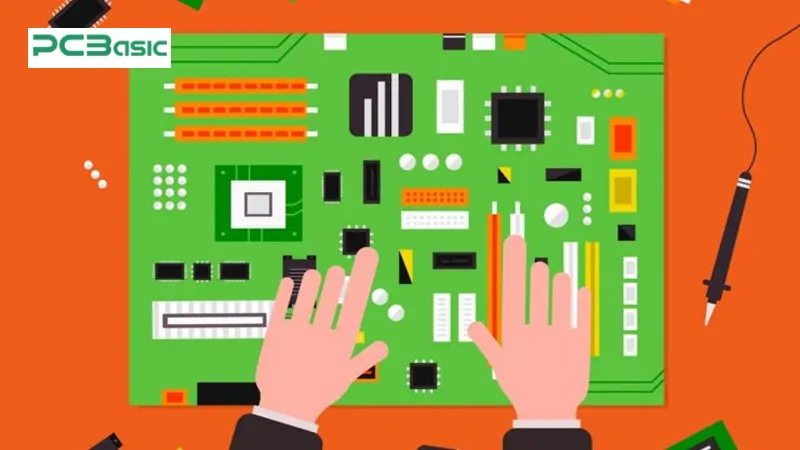
The keyboard PCB has to be designed quite elegantly in terms of both its size and layout. Now you might want a compact 60% keyboard, a versatile format, or something else, but it should snugly fit only within your desired dimensions. Here, you would have to make decisions on standard or custom placement of keys so that all of them will sit perfectly with the corresponding switches and stabilizers.
The lay is put where keys, switches, stabilizers etc. and other accessories such as rotary encoders or OLED displays will be. Good planning here balances the design on ergonomic as well as aesthetic grounds while retaining compatibility with the keycap and case.
Another major consideration in PCB design is the kind of switches you want to use. This may involve the spacing of switches, pin requirements for 3-pin or 5-pin switches, and support for hot-swap sockets. Proper spacing is very critical for easier assembly and the registration of keypresses without fail.
Moreover, supporting several switch types—linear, tactile, or click—is simply another avenue for personalization. Some of the PCBs have switch plate arrangements that affect the typing feel and acoustics; thus, alignment is enormously very necessary with user preference.
PCBA layer forms a strategic keyboard PCB material layup. It is for the purpose of creating good and efficient signal routing. This process is relatively complex; nonetheless, it minimizes the exposure of EMI while keeping clean electrical signals as well as an uninterrupted flow. These PCBs are mainly used in advanced keyboard designs, which are more compact in layout and better for thermal management. Proper grounding and trace width optimization become critical for improvement in performance and life.
Such features as RGB lighting and even artistic silkscreen designs are designed to enhance the beauty of the board. Those that are made compatible with RGB add their requirements to the planning placement of LEDs, their corresponding controller chips, and firmware programming to give attention to the dynamic effects of lighting.
Clear or transparent cases would reveal such aesthetic enhancements, making a keyboard not only usable but also one to talk about. More advanced designs can have under-glow lighting or per-key personalization, which involves much more advanced planning at the design stage of the PCB.
Once the suitable sort of communication protocol, such as USB, Bluetooth, or even a hybrid combination, and the interface is chosen, it plays a relatively more significant role since it is directly related to the keyboard's data transfer efficiency, stability, and power consumption. USB-C has become a trend because of its reversible design and fast data transfer rates, and Bluetooth is absolutely wireless, supporting portability. Some such designs come with the dual-mode connectivity feature, which allows users to shift to the keyboard's two modes of operation: wired and wireless.
These are debugging programs that require planning beforehand; a user will then find test points for debugging electrical verification, headers for debugging tools, and the bootloader, which is for updating firmware after assembly. Custom firmware like QMK or VIA basically accompanies the most advanced keyboards; this will allow one programmatically to configure the layout, macros, or even lighting effects. Thus, planning into this phase ensures smoother production and use post-assembly.
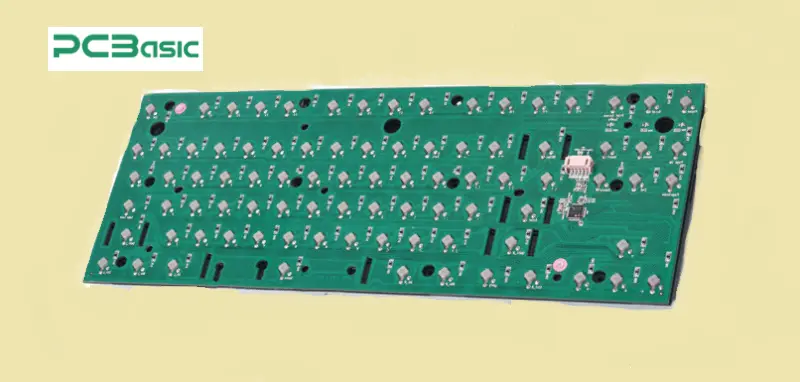
A detailed schematic design is essentially the body of any successful PCB. It pinpoints the functional connection and the electrical interconnections of the components, along with a blueprint for the entire project. This is where the components are ensured to be reasonably connected in a logically rational way that prevents most of the possible design errors right at the onset.
Once the schematic is stabilized, it may go for a detailed layout design for a keyboard PCB. Here lies the actual placement of elements on the board, trace routing that is interference-free for signals, and diagrams of voltage levels with a spreading of power. Great care needs to be taken there with regard to achieving high performance and manufacturability.
Prototyping is one of the most elementary validation stages in the development of PCB. Thus, it will enable designers to construct a working model of their keyboard PCB and, design errors and check circuit performance. It is, therefore, that mistakes and anomalies get corrected by the developers before changes can be enforced to ensure that the final product meets the desired functional and reliability requirements before mass production.
It then places this prepared keyboard PCB with great care, soldering components onto the board, connecting them to the circuit, and so on. It then tests the working of the PCB through high-intensity testing to determine whether the signals are integral or the specifications are met by the board. The board is debugged and tested iteratively till it fulfills all the quality and performance requirements and is defect-free.
An appropriate keyboard layout and size would ensure that the keyboard meets all your needs in any application, from gaming to simple typing.
Confirm that the keyboard PCB accepts the type and number of switches you will be using.
Decide how much permanence and stability you need (soldered) or flexibility for switch experiments.
Evaluate if the keyboard firmware and software support your intended use and perform with the best capability to update.
Trustworthy brands bring reliability, while quality components ensure the keyboard PCB's longevity and optimal performance.
Balance the advantages, the quality of the construction, and financial limitations of keyboard in wise buying choices.
Whether extra RGB support would be required for better visuals and whether this fits into your customization plans needs to be determined.
The right PCB, switches, plate, and case all contribute to building your keyboard's overall quality and functionality. Proper time should be taken to choose parts that meet your needs.
Build your DIY keyboard carefully, ready to debug the errors of its parts so that it performs best together.
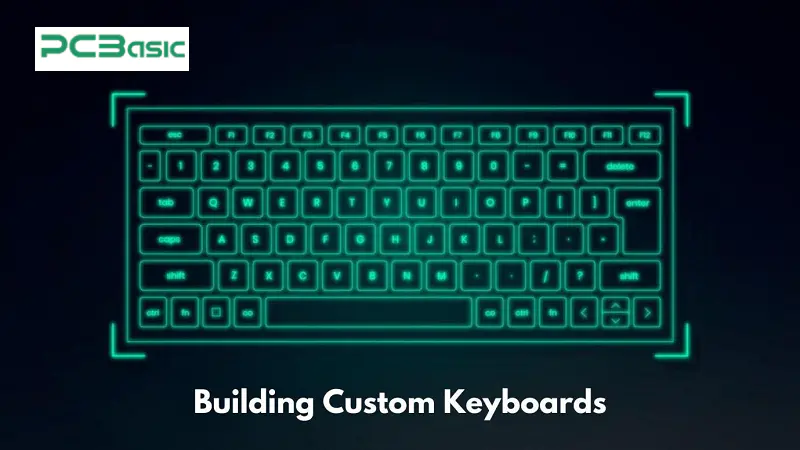
PCBasic supports keyboard PCB directly from the original manufacturers at competitive prices for quality products.
Whether you are a passionate DIY practitioner or a professional gamer, PCBasic produces fine models that meet your demands and preferences.
You can then enjoy your peace of mind knowing that the keyboard PCBs are well crafted through the highly accurate manufacturing process of PCBasic.
Take advantage of firmware upgrade support and dedicated one-to-one customer service to answer all your questions regarding your keyboard PCB.
Efficiency is the goal: Every order ships in 24 hours with a no-question-asked 7-day return for the best shopping experience.
It is fulfilling to build a mechanical keyboard from scratch. Knowing PCBs for keyboards, design intricacies, and what makes them different shows that you are in control of your creation as it goes to represent you and your style as well as the qualities you want from a performance. Engage in this exciting, ingenious process and heighten your typing game with a masterpiece tailored by your hands. If you need more information about these components, you can find more or talk to the specialists. Discover mechanical keyboards!
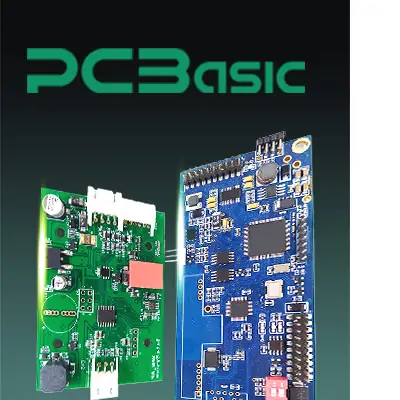 About PCBasic
About PCBasic
Time is money in your projects – and PCBasic gets it. PCBasic is a PCB assembly company that delivers fast, flawless results every time. Our comprehensive PCB assembly services include expert engineering support at every step, ensuring top quality in every board. As a leading PCB assembly manufacturer, we provide a one-stop solution that streamlines your supply chain. Partner with our advanced PCB prototype factory for quick turnarounds and superior results you can trust.

Assembly Enquiry
Instant Quote
Phone contact

+86-755-27218592
In addition, we've prepared a Help Center. We recommend checking it before reaching out, as your question and its answer may already be clearly explained there.
Wechat Support

In addition, we've prepared a Help Center. We recommend checking it before reaching out, as your question and its answer may already be clearly explained there.
WhatsApp Support

In addition, we've prepared a Help Center. We recommend checking it before reaching out, as your question and its answer may already be clearly explained there.
